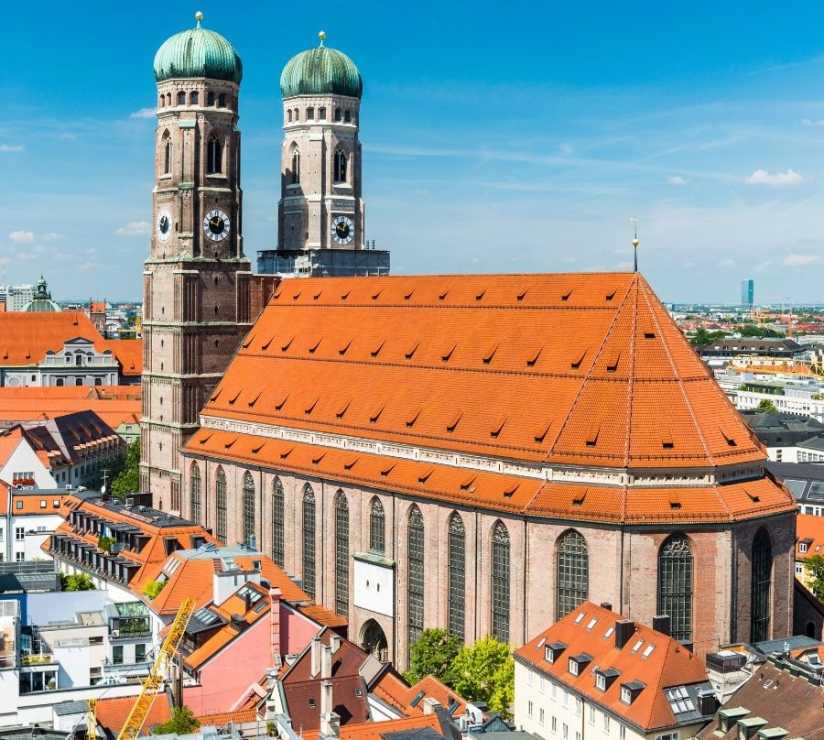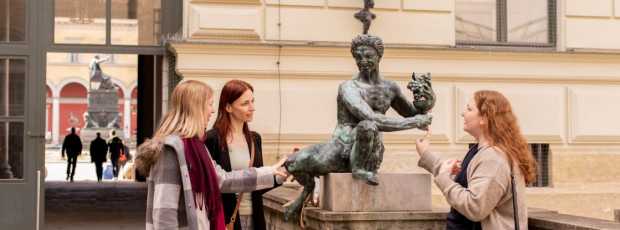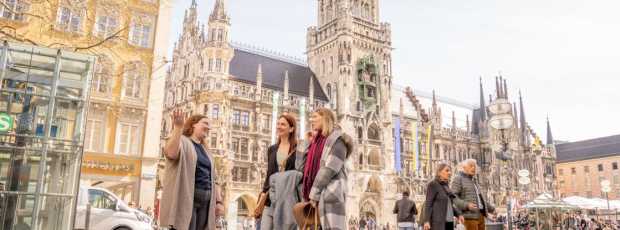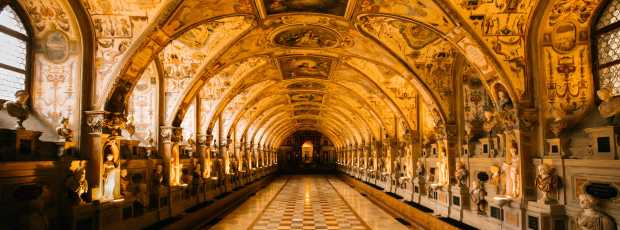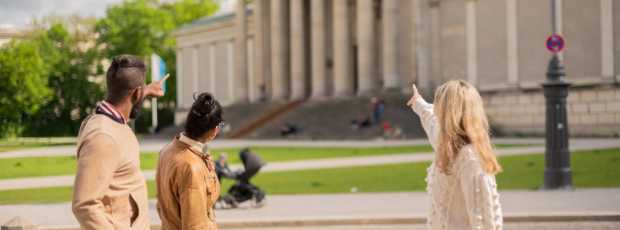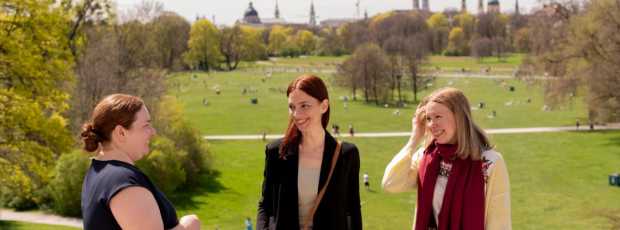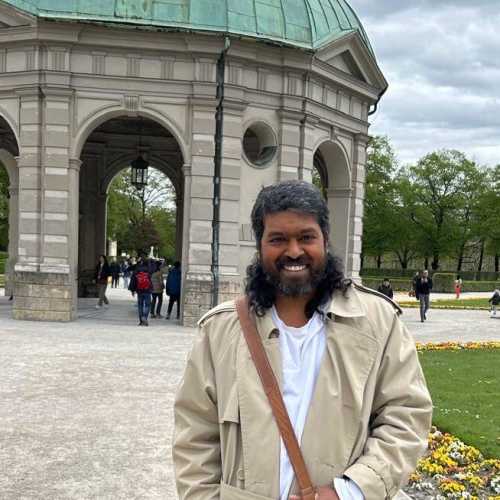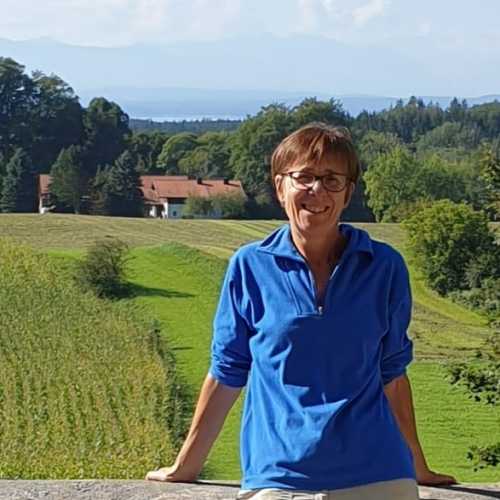Table Of Contents
- Start With the Sky: Munich's Rooftops and Views
- Beer Gardens and Beer Culture Without the Hype
- The Museums Locals Actually Visit
- Parks That Change With the Seasons
- Guided Tour Options vs Going Solo
- The Local Spin on Must-Sees
- Local Spots You'd Miss Without a Guide
- From Dachau to Nymphenburg: Reflections and Range
- Seasonal Munich: From Christmas to Summer Bikes
- Allianz Arena: Munich's Modern Marvel
- The Honest Ending: What Not to Miss and What to Skip
![Rooftop view over Munich's Altstadt with the Alps faintly visible in the background.]()
You want to know the best spots to go in Munich? The ones that actually matter to people who call this city home?
Good. Pull up a chair and let me tell you what deserves your attention. I'll also tell you what's just tourist trap nonsense.
![Early morning commuter walking through Marienplatz.]()
Munich isn't just another city on your European trip. It's a place where locals have strong opinions about everything.
From which beer gardens actually matter to which museums are worth your ticket money. I've seen this city change over the decades. Some changes are good, others make me want to hide indoors.
Start With the Sky: Munich's Rooftops and Views
The city's rooftops tell you everything about Munich when you know where to look.
Most people trudge up Alter Peter because their guidebook told them to. Fine. But here's what they don't mention.
Go early, before 9 AM, when the light hits the tower just right. That's when you can actually think without crowds.
![Sunrise over the city from Old Peter's observation deck.]()
I take visitors up Old Peter because it still offers the best views in the city. Yes, even with the crowds. The trick is timing and patience.
The church opens at 9 AM most days. By 10 AM, you're sharing the platform with tour groups taking selfies.
The tower provides panoramic views across Munich's rooftops toward the Alps.
![Locals having coffee on a rooftop terrace near the Isar.]()
What I really enjoy are the smaller rooftop spots.
These don't make it into guidebooks. The tower at Peterskirche gives you height. But there are plenty of quiet terraces where locals grab coffee.
They watch the city wake up. You won't find these places on Google Maps. That's what makes them special.
Beer Gardens and Beer Culture Without the Hype
Let's discuss outdoor drinking areas without pretending they're some magical wonderland. They're drinking spaces with decent food and questionable toilets.
But they're also where locals actually go. That makes them valuable for experiencing Munich.
![Locals playing chess and drinking beer in a beautiful garden. ]()
The beer halls everyone knows about? Hofbräuhaus is a circus.
Go if you must, but understand what you're getting. Overpriced beer and accordion music for people who think lederhosen define German culture.
Real locals roll their eyes at the place. Munich has much better beer halls when you know where to look.
![Classic Munich beer hall interior with wooden tables.]()
Augustiner-Bräu is different. It's still touristy, but at least the beer is decent.
The setting feels less manufactured than other similar places. The locals who work nearby actually eat lunch there. That tells you something about the quality. Munich beer culture runs deeper than tourist traps.
Looking for a private city experience in Munich?
Explore the city with a local who plans a private day just for you; no groups, no scripts.
The Museums Locals Actually Visit
Deutsches Museum is where I take my nephew when he's bored during school holidays. It's enormous, slightly overwhelming, and genuinely fascinating.
That's assuming you like understanding how things work. Most tourists skip it because it's not pretty enough for Instagram. Their loss, really.
![Modern tech exhibit at Deutsches Museum. ]()
The museum sprawls across an island in the Isar River. You could easily spend a full day there. The aviation section alone justifies the ticket price.
But pace yourself, because museum fatigue is real.
The Deutsches Museum covers everything from mining to space travel. It's Munich's most comprehensive museum experience.
![Vintage aircraft display at Deutsches Museum. ]()
BMW Welt is tourism disguised as corporate marketing, but it functions well.
The building itself is impressive. Should you be into cars or design, you'll find plenty to appreciate. Plus, it's free, which in Munich is almost revolutionary. The design makes BMW Welt worth visiting even if you hate cars.
The museum portion costs extra. But the main showroom gives you enough BMW obsession for most people.
The engineering is the real star here. All curves and glass and very German confidence. BMW Welt sits in Munich's newer district, showing the city's modern face.
![BMW Welt interior with concept cars.]()
Parks That Change With the Seasons
English Garden isn't actually English. That seems fitting for a city that takes its identity seriously. It's bigger than Central Park and full of locals doing everything.
Tai chi, nudist sunbathing. Yes, really. The English Garden defines Munich's relationship with nature. If you love parks, also consider visiting Olympic Park.
![Cyclist near the English Garden in autumn.]()
The Isar River runs through the park. In summer, locals treat it like their personal swimming pool. The water is cold and fast.
That doesn't stop anyone though. You'll see people floating downstream on inner tubes. It's completely normal behavior here.
Chinese Tower sits in the middle of the park. It's surrounded by another beer garden. It's touristy but functional.
The walk there through the park is pleasant regardless of season. In winter, the whole area transforms completely. Quieter and more contemplative.
![Summer picnics near the Chinese Tower.]()
Sports activities happen everywhere in the Englischer Garten. Football, frisbee, volleyball.
People running with an intensity that suggests they're training for something important. The nature here feels managed but not artificial.
That's harder to achieve than you'd think. Munich balances urban life with green spaces better than most cities.
Guided Tour Options vs Going Solo
Here's where I need to be honest about guided tour experiences in Munich. Most group tours rush through the same five stops. They hit Marienplatz, peek at a beer hall, and call it done.
A typical guided tour gives you surface-level Munich knowledge.
![Tour group gathered around a guide in Marienplatz.]()
But some guided tour approaches function better. Private guides who actually live here can show you things you'd miss otherwise.
They know which drinking spots locals prefer. Which museums deserve your time. A good guided tour saves you from tourist traps while revealing real Munich culture.
The difference is personal connection versus mass tourism. I'd rather see fewer places with real context than rush through a checklist with no understanding.
Munich rewards depth over breadth. That's true whether you're on a guided tour or exploring solo.
What if your day in Munich was planned by someone who knows it — and you?
City Unscripted matches you with a local host who creates a private experience based on your interests, not a set route.
The Local Spin on Must-Sees
Munich Residenz is where Bavaria's kings lived when they had kings. The palace is huge, ornate, and exhausting. That's typical of royal residences though.
Go if you like gold leaf and historical excess. The Munich Residenz demonstrates how Bavaria's rulers spent their money.
![Inside the Residenz Palace hallway with ornate decorations.]()
Max Joseph Platz connects the Residenz Palace to the opera house. It creates a little pocket of high culture in the city centre. It's pleasant for a quick walk.
Don't expect to linger unless there's a performance you're attending. Max Joseph Platz anchors Munich's cultural district nicely.
The opera house itself merits seeing. Even if you're not seeing a show. The design is impressive.
It anchors this part of the old town nicely. But Munich isn't really about opera culture. Not the way Vienna or Berlin might be. The building serves Munich's cultural scene without dominating it.
![Residenz Palace façade at twilight. ]()
Local Spots You'd Miss Without a Guide
The magnificent buildings in Munich aren't all marked with plaques.
Some of the best design hides in plain sight.
Tucked behind main streets or mixed with modern construction. Munich's architectural gems reward curious visitors who walk beyond main routes.
![Quiet courtyard tucked behind the main square. ]()
Public transport in Munich works efficiently. That means you can explore neighborhoods that tourists typically skip.
The S Bahn and U Bahn connect the center to areas. Areas where locals actually live and work. Munich's transit system opens up the real city beyond tourist zones.
Should you want to see Munich beyond the postcard version, consider a private tours in Munich approach.
Unlike group tours that rush through the same five stops, a local guide can show you spaces. The royal garden areas that don't make it into guidebooks.
![Small garden courtyard in residential area. ]()
The churches in Munich range from tourist magnets to neighborhood gems. Peter's Church gets the crowds.
But smaller parishes offer design and ambiance. Without the photo-taking crowds.
Munich's churches tell the city's religious and cultural history. Many locals still attend services at these neighborhood churches.
From Dachau to Nymphenburg: Reflections and Range
Dachau concentration camp sits 30 minutes from Munich by train. It's a sobering trip that puts the city's recent history into perspective.
The memorial doesn't sugar-coat anything. That's exactly as it should be. Dachau Concentration Camp reminds visitors that Munich sits within complex German history.
![Reflective visitor walking near the Dachau memorial.]()
The contrast between Dachau and Nymphenburg Palace captures something essential.
It demonstrates Germany's relationship with its past.
One location represents the worst of human behavior. The other displays King Ludwig's expensive taste in baroque design.
Munich contains both realities within easy reach.
Nymphenburg Palace spreads across manicured grounds. It feels more like a small town than a single building. The palace itself is impressive.
But the gardens are where locals bring their children. To run around and feed ducks. Nymphenburg Palace serves Munich families as much as tourists.
![Nymphenburg Palace front view with reflecting pool.]()
King Ludwig II gets credit for Neuschwanstein. But his family's Munich palace displays their wealth differently, in a more understated way.
The art collection is genuinely impressive. King Ludwig's legacy in Munich feels more intimate than his famous castle. The palace gardens remain popular with Munich locals year-round.
Tip
We match you with the right host, not just any guide.Want to experience the real Munich with someone who lives there?
A fully private experience, planned and led by a local host who tailors the day to you
Seasonal Munich: From Christmas to Summer Bikes
Christmas market season in Munich means crowds and overpriced glühwein. Vendors selling the same crafts you'll find in every German city.
But the mood works.
Especially if you embrace the commercial cheerfulness. Munich's Christmas market tradition runs deep. Even cynical locals enjoy the transformation.
![Christmas lights over market stalls at dusk. ]()
Winter changes the city's daily patterns completely. The outdoor drinking areas close or move indoors. The parks empty out.
Locals spend more time in cafes and museums. It's different, not worse.
Munich adapts to winter with indoor culture. The city becomes more contemplative during cold months.
Summer brings out the bikes everywhere. Munich becomes a cycling city in warm weather.
Locals use bikes for everything. The bike paths are extensive and mostly safe.
Summer cycling defines Munich's outdoor culture. The city changes into a two-wheeled paradise.
![Summer cyclists in Englischer Garten.]()
Oktoberfest dominates September and early October. It transforms parts of Munich into a massive beer festival. locals have mixed feelings about it.
The money is good for the city. But living here during the festival requires patience. Oktoberfest brings the world to Munich. Whether locals want it or not.
Allianz Arena: Munich's Modern Marvel
This Munich landmark deserves its own discussion. It's worth seeing if you're into football or modern design. The building changes colors based on which team is playing.
The engineering is impressive. Even if you don't care about Bavaria Munich's latest season. Allianz Arena demonstrates Munich's commitment to cutting-edge construction.
![The Arena lit up in red at night. ]()
The stadium sits in Munich's north district. Getting there requires planning via public transport. But the journey reveals parts of Munich most tourists never see.
Allianz Arena connects to the city through efficient transit links. It's not just a football venue. It's a statement about modern Munich.
During match days, the energy around the stadium electrifies the whole area. Locals and visitors merge into one excited crowd.
The S Bahn fills with fans wearing team colors. Munich's football culture comes alive during these moments. The venue creates community beyond just sports activities.
The Honest Ending: What Not to Miss and What to Skip
So what's actually worth visiting in Munich? The attractions that matter are specific ones.
Places where locals and visitors can coexist. Without anyone feeling like they're performing for anyone else.
Munich functions best when experiences feel natural.
![Sunset reflecting off the New Town Hall. ]()
Don't miss the simple pleasures that make Munich livable for its residents. Sitting by the Isar River with coffee.
Watching people walk their dogs in the parks. Taking the train to see how neighborhoods change as you move away from the tourist center. Walking through New Town Hall.
These moments matter more than checking off attractions.
Munich functions optimally when you stop trying to visit every museum and palace. The city rewards patience and curiosity more than aggressive sightseeing.
Take time to sit in a beer garden. Walk through neighborhoods that don't appear in guidebooks. Remember that the best Munich experiences happen naturally.
![Locals sitting by the Isar with drinks at evening.]()
The Alps are located close enough for day trips. Italy is reachable by train. The rest of Bavaria offers small town charm. That contrasts nicely with Munich's urban energy.
But honestly, there's enough in this city to keep you busy without leaving Munich at all.
What I hope you take from this isn't just a list of places to visit. It's an understanding that Munich rewards people who approach it with curiosity rather than a checklist mentality.
The world is full of cities that perform their identity for visitors. Munich is confident enough to just be itself.
![Quiet street scene in a residential Munich neighborhood.]()
Ready to plan your perfect day in Munich?
Start your experienceWhat if your day in Munich was planned by someone who knows it — and you?
City Unscripted matches you with a local host who creates a private experience based on your interests, not a set route.
Want to experience the real Munich with someone who lives there?
A fully private experience, planned and led by a local host who tailors the day to you
